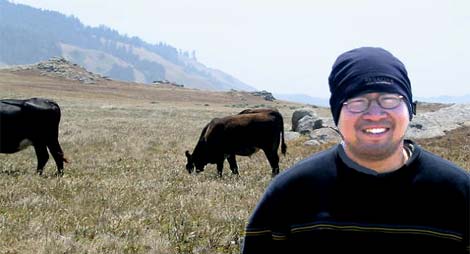FORT ROSS, CA – We have arrived here at Archy Camp to begin our one-month journey of understanding the lifestyles of Colony Ross and the colonists' interactions from 1812-1841 with the Kashaya Indians, after which we will devise a Kashaya interpretive trail. The team is made up of professional undergraduates, graduates, professors, and representatives of the Kashaya tribe including Otis Parrish, Vivian Parrish, and Violet Parrish, whose mother, Essie Parrish, was the previous spiritual leader of the tribe.
Otis, Vivian, and Violet have been monumental in giving us an understanding of their culture and the land they live in. On one occasion, I woke up at 5:55 a.m. from the mooing of cows and decided to get an early start. As I was standing near the benches talking to one of the GSI's (Graduate Student Instructors) about the mooing and the turkey gobbles of the night before, Otis arrived in his car screaming; "Where's the fire! Where's the fire!"
He parked his car while still continuing to scream, "Where's the fire!" To me, this was quite confusing. At first, I thought he was asking where breakfast was. But then he started picking up wood and ordered the GSI to look for paper. Otis explained that everything in nature is a woman, from the fog that rolls in the morning, to the sun itself. And fire is a sign of welcome, and every morning you must build a fire to welcome the morning. As the fire began to get stronger, Otis welcomed everyone who woke up to the fire, which they greatly appreciated. Once everyone gathered and started to prepare breakfast, Otis talked about the fog that tends to engulf this section of the California coast.
According to Otis, a long time ago, when fog started to settle in the Kashaya village, the women of his tribe would walk onto the ridge and sing songs and dance. At the end of the dance, the women would moon the ocean, which is the source of the fog. The fog, who is a woman herself, would see other women and retreat to the ocean, said Otis.
Here at Fort Ross, other than learning about Kashaya culture, we also are learning fundamental techniques for locating possible archaeological sites — locations of past human activities. Dr. Roberta Jewett (an archaeologist and the field manager for all our archaeological work) gave us a hint that in addition to changes in soil color, soil composition, and general soil vegetation, the growth of thistle is a telltale sign of past human activities. Using this thistle technique, Professor Kent Lightfoot took us to old Highway 1 near Fort Ross, and introduced us to a possible archaeological site. Looking around, we found debris of wood beams and metal roofs and, just as Dr. Jewett indicated, thistles surrounded each artifact.
Other than the morning wake-up calls from the cows and wild turkeys, our daily life here at Fort Ross Archy Camp has been full of collaboration between the Kashaya elders, Professor Lightfoot, Dr. Jewett, State Park employees and the rest of the archaeological crew. Added to all this archaeology, we get desserts with our dinner (tonight, strawberries with whipped cream). Topping this off is a good, crazy contest between the undergrads of who can eat 10 Saltine crackers in a minute.* The professors can only look on in confusion.
Fort Ross is going great, and everyone is learning and having a great time …
— Jim
*No one can eat 10 saltines in a minute!
Jim Betinol is a fourth-year Anthropology/Archaeology major.






